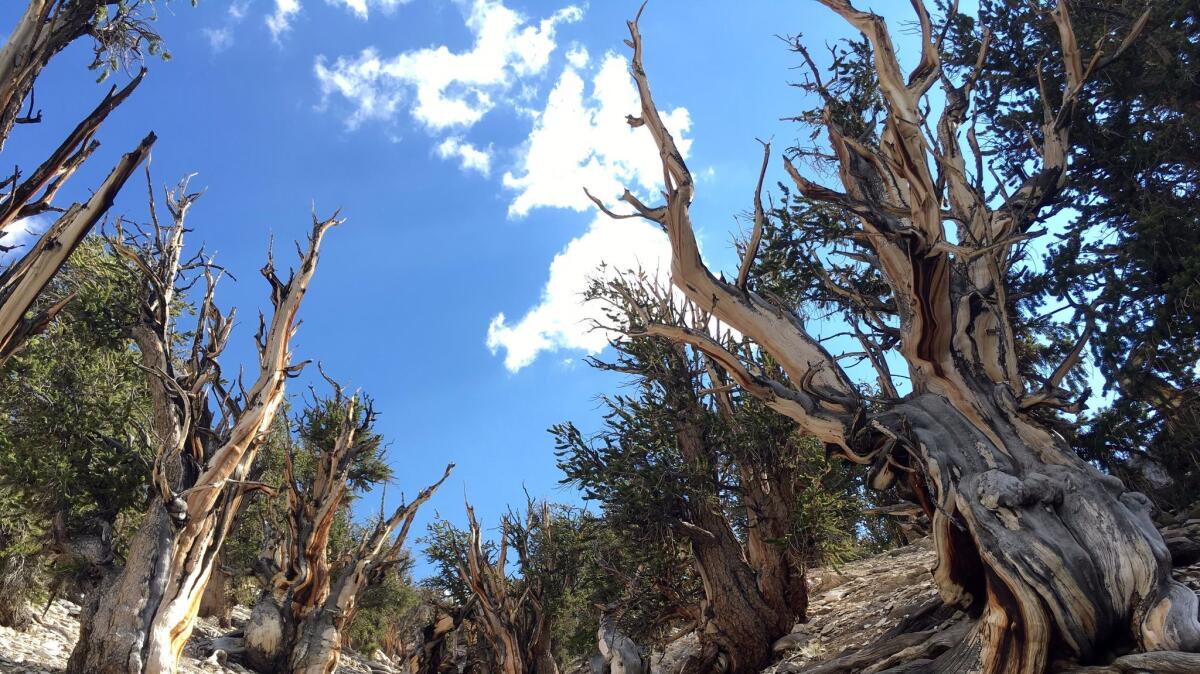Op-Ed: Slow trees and climate change: Why bristlecone pine will still outlive you

In a time of relentless change, it’s soothing to contemplate deeply rooted, long-lived trees. But now our climate of uncertainty affects even Great Basin bristlecone pine, Pinus longaeva, the species with the world’s oldest known individuals. How should we respond? With alarm, indifference or something else?
Recently, a team of botanists published an article on “divergent responses of tree species and life stages to climatic warming in Great Basin subalpine forests.” In the White Mountains of eastern California, tree lines are ascending. Bristlecone pines have been less successful at colonizing the new growth zone than neighboring limber pines. The scientists described limbers “leapfrogging” bristlecones “in slow motion.” Over time, P. longaeva could face “overall range contraction and possibly local extirpations.”
What once might have been slow news, or no news, entered the fast news cycle. UC Davis, the lead author’s employer, prepared a press kit. Media relations changed the metaphor from “leap frog in slow motion” to “race to the top,” and implied that land managers should try to fix the game so that bristlecone wins. After a journalist adapted the university press release, the AP issued it for syndication with a sensational headline, and a technical study completed its conversion into clickbait: “Scientists: Future of Oldest Tree Species on Earth in Peril.”
In truth, scientists are not worried about the extinction of bristlecone pine in the manageable future.
Our climate of uncertainty affects even Great Basin bristlecone pine, Pinus longaeva, the species with the world’s oldest known individuals.
Ecologists can make educated guesses about how bristlecone populations — which occur with and without limber pine — might change in the long term, meaning millenniums. That is different than soothsaying. In a separate report, tree-ring researchers demonstrated that subalpine bristlecones have grown faster in the last half century than any 50-year period in the last 3,700 years. Whether global warming is “good” or “bad” for P. longaeva depends on the time frame. Regardless, it should give us pause that even the oldest trees on the highest tree lines are subject to our out-of-control planetary experiment.
Let’s assume that over the next 1,000 or 10,000 years of human-accelerated climate change, limber pine proves to be more adaptable than bristlecone pine. Would that be reason for anxiety or sorrow? Why not praise the resilience of Pinus flexilis, a tree that occurs from Canada to Mexico, in high and low altitudes, attaining ages up to 2,000 years.
The snag is that limbers lack mystique. Only one tree species can hold the title World’s Oldest, and bristlecone pine has been that champion since the 1950s.
A dethroned “oldest” title holder, giant sequoia, remains iconic because of its monumental size. During the historic 2011 — 2017 drought, journalists went to the Sierra Nevada again and again to ask field experts if the big trees were imperiled. In fact, sequoias held up remarkably well. Reporters duly submitted stories about how the giants might succumb, only belatedly giving attention to the tens of millions of dead and dying trees of other species all around them.
Beyond commercial factors — the algorithms that decide which stories are “engaging” — I wonder why some people “like” narratives of ancient trees in imminent danger. Perhaps climate activists believe, without evidence, that alarmist stories will win over skeptics, contrarians and deniers. Or perhaps these stories are expressions of collective grief. People who have lost environmental hope may derive eco-schadenfreude from visualizing how climate change foredooms even the most persistent organisms.
The carbon crisis is changing everything, though some things will change faster than others, and at the local level, global warming will create winners along with losers. As a general proposition, today’s big old trees — winners in an older climate— will eventually fall into the losing column.
Consider the uncertain fate of California’s emblematic megaflora. Joshua trees could be pushed out of low-elevation Joshua Tree National Park within a century. In Redwood National and State Parks, the world’s tallest organisms rely on the marine layer and may become vulnerable to summer-fog decline. The individually named giants of Sequoia National Park survived the recent drought and worse ones in the past, yet it’s unclear if they could withstand an extreme year like 2014 once a decade, a potential climate scenario.
For those who love the Golden State’s superlative trees, this list of possibilities stirs disquiet. It’s understandable to add a worry line for bristlecones. At the same time, a different moral can be taken from P. longaeva, a species that specializes in making do.
In the inhospitable White Mountains, visitors linger amid unhuman but relatable beings — trees that have stayed rooted in their home place for more than 4,000 years. The federally protected Ancient Bristlecone Pine Forest encourages long-term imagination, a precious resource in our political economy of short-termism. We can use this deeper time frame to fret about trees in future millenniums. We might also take inspiration from these Methuselahs to think ahead just one century, when the greatest climate victims will be human beings. “Climate Change in the American Mind,” a 2017 polling report, showed that Americans are more concerned about the climatic threat to plants than people. Speaking as a plant person, I think that’s upside-down. If we could swiftly tend to our world, including the weak and the poor, bristlecones, at least, would slowly continue to take care of themselves.
Jared Farmer is a professor of history at Stony Brook University and the author of “Trees in Paradise: A California History.”
Follow the Opinion section on Twitter @latimesopinionand Facebook
More to Read
A cure for the common opinion
Get thought-provoking perspectives with our weekly newsletter.
You may occasionally receive promotional content from the Los Angeles Times.






